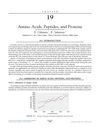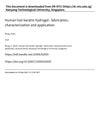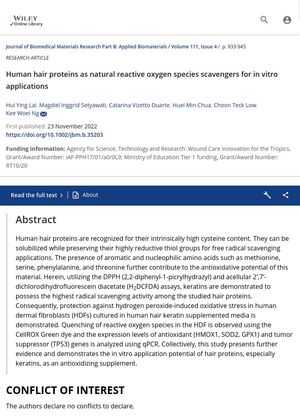TLDR Human hair proteins, especially keratins, can protect cells from oxidative stress in lab settings.
The research paper "Human hair proteins as natural reactive oxygen species scavengers for in vitro applications" presents a study on the antioxidative potential of human hair proteins, particularly keratins. The study found that these proteins, due to their high cysteine content and the presence of other amino acids like methionine, serine, phenylalanine, and threonine, have a high radical scavenging activity. Using DPPH and H2DCFDA assays, keratins were shown to have the highest radical scavenging activity among the studied hair proteins. The study also demonstrated that human dermal fibroblasts (HDFs) cultured in human hair keratin supplemented media were protected against hydrogen peroxide-induced oxidative stress. The quenching of reactive oxygen species in the HDF was observed using the CellROX Green dye and the expression levels of antioxidant (HMOX1, SOD2, GPX1) and tumor suppressor (TP53) genes were analyzed using qPCR. This suggests the potential of hair proteins, especially keratins, as an antioxidizing supplement in vitro.
 12 citations
,
December 2017 in “Journal of biomaterials science. Polymer ed.”
12 citations
,
December 2017 in “Journal of biomaterials science. Polymer ed.” Human hair protein extracts can protect skin cells from oxidative stress.
118 citations
,
January 2013 in “Biomaterials” Keratin from human hair shows promise for medical uses like wound healing and tissue engineering.
 54 citations
,
January 2013 in “Journal of Biological Macromolecules”
54 citations
,
January 2013 in “Journal of Biological Macromolecules” A new method effectively separates keratin-associated proteins and keratin from human hair.
41 citations
,
May 2012 in “Advanced Healthcare Materials” Human hair keratins improve cell adhesion and growth on culture surfaces.
517 citations
,
February 2010 in “Materials” Keratin from hair and wool is used in medical materials for healing and drug delivery.
 98 citations
,
June 2001 in “Journal of biological chemistry/The Journal of biological chemistry”
98 citations
,
June 2001 in “Journal of biological chemistry/The Journal of biological chemistry” A cluster of sulfur-rich hair protein genes was found on chromosome 17.
10 citations
,
January 1989 in “Archives of Dermatological Research” The method effectively analyzes human hair proteins, especially nonfilamentous ones.
 5 citations
,
January 2017 in “Elsevier eBooks”
5 citations
,
January 2017 in “Elsevier eBooks” The document concludes that cosmetics need biocompatible, eco-friendly ingredients due to aging populations and demand for effective products.
 12 citations
,
December 2017 in “Journal of biomaterials science. Polymer ed.”
12 citations
,
December 2017 in “Journal of biomaterials science. Polymer ed.” Human hair protein extracts can protect skin cells from oxidative stress.

Keratin hydrogels from human hair show promise for tissue engineering and regenerative medicine.
 February 2025 in “Animals”
February 2025 in “Animals” Understanding proteins in skin structures like claws and hair is crucial for future research.
 4 citations
,
December 2018 in “Macedonian Journal of Chemistry and Chemical Engineering”
4 citations
,
December 2018 in “Macedonian Journal of Chemistry and Chemical Engineering” A new method accurately measures amino acids in treated hair, showing bleaching reduces amino acids while protein treatments increase them.
3 citations
,
September 2014 in “SpringerPlus” Human hair loss may have evolved to help increase brain size.







